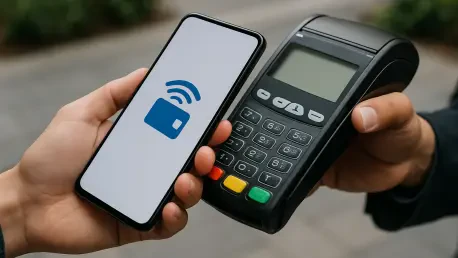In an era where digital transactions underpin nearly every aspect of daily life, the surge of mobile-first payments is fundamentally altering the landscape of buying and selling across the globe, from the vibrant marketplaces of the Middle East to the far-reaching corners of Africa. Consumers are increasingly turning to smartphones as their primary tool for purchases, often sidestepping traditional card-based systems entirely. This transformation, propelled by the explosive growth of e-commerce and widespread smartphone adoption, represents more than a fleeting trend—it signals a profound shift in the mechanics of global trade. The Middle East, Turkey, and Africa (META) region stands out as a crucible of innovation in this domain, providing a window into potential future developments. As this wave of change gains momentum, the question looms: could mobile-first payments redefine commerce on a worldwide scale?
The scale of this shift is staggering, with global e-commerce spending reaching $6.8 trillion last year and projections estimating a climb to $10.8 trillion by 2030. With roughly a third of the world’s population engaging in online shopping, the appetite for rapid, frictionless payment options has reached unprecedented levels. Traditional methods like credit and debit cards, once considered the benchmark for transactions, are increasingly falling short of modern expectations for speed and ease. Alternative payment methods (APMs), such as mobile wallets and app-driven solutions, are stepping into this gap, delivering not only efficiency but also access for countless individuals without bank accounts. For businesses, ignoring this evolution is no longer an option—adaptation to these new systems is critical to staying relevant in a fiercely competitive environment.
The Rise of Mobile-First Commerce
Why Mobile Payments Are Taking Over
The global explosion in smartphone usage has reshaped consumer behavior, nowhere more evidently than in the META region, where mobile adoption rates are soaring. Smartphones have become the go-to device for shopping, overtaking desktops as the preferred platform for online purchases. This trend is driven by the convenience of mobile apps and the ability to shop on the go, aligning perfectly with the fast-paced lifestyles of today’s consumers. Beyond mere preference, the proliferation of advanced networks like 5G has played a pivotal role, enabling seamless, high-speed transactions that make mobile payments not just viable but often superior to other methods. In markets where internet infrastructure is rapidly improving, this technological backbone ensures that mobile-first commerce isn’t just a luxury but a practical reality for millions, setting the stage for broader adoption.
Moreover, the impact of mobile payments extends beyond convenience to fundamentally alter economic participation. In the META region, where many areas boast near-universal mobile phone ownership, these devices are often the only gateway to digital commerce for large segments of the population. Unlike traditional banking systems that require physical infrastructure and formal identification, mobile payments lower the barriers to entry, allowing users to engage in transactions with minimal prerequisites. The role of 5G and enhanced 4G networks cannot be overstated here, as they reduce latency and improve reliability, ensuring that even complex transactions can be completed swiftly. This technological leap is not merely supporting a trend but actively accelerating the shift toward a mobile-centric commercial ecosystem.
Shifting Consumer Preferences
A marked transition from desktop-based shopping to mobile app-driven purchases is redefining how consumers interact with e-commerce platforms. In-app checkouts, which streamline the payment process into a few quick taps, are gaining immense popularity for their simplicity and speed. This shift reflects a broader cultural move toward immediacy, where waiting for a desktop to load or navigating multi-step payment processes feels outdated. Particularly in the META region, where mobile devices often serve as the primary or only internet access point, consumers are embracing these solutions as a natural extension of their daily digital habits. The preference for mobile-first experiences is not just about ease—it’s about aligning commerce with the tools most integrated into modern life.
Equally significant is how mobile-first solutions address the challenges of regions with low card penetration, making commerce far more accessible. In many parts of the META region, traditional payment cards remain out of reach for a substantial portion of the population due to limited banking infrastructure or stringent eligibility criteria. Mobile payments bypass these hurdles by leveraging widely available technology—smartphones—to facilitate transactions without the need for a formal financial intermediary. This accessibility empowers individuals to purchase goods, subscribe to services, and participate in the broader digital economy, often for the first time. By catering to these underserved markets, mobile-first commerce is not only meeting consumer demand but also expanding the very definition of who can engage in global trade.
Alternative Payment Methods (APMs) as Game-Changers
Innovations Driving Change
At the heart of the mobile payment revolution are innovative alternative payment methods like Direct Carrier Billing (DCB) and Direct Wallet Billing (DWB), which eliminate the dependency on traditional banking systems. DCB allows users to charge purchases directly to their mobile phone bills, while DWB draws from stored-value digital wallets, offering a straightforward way to pay without a credit card or bank account. These methods are particularly impactful in emerging markets where mobile phone usage far outstrips access to conventional financial services. Their simplicity and integration into everyday technology make them a powerful tool for enabling transactions, appealing to a broad swath of consumers who prioritize ease over complexity in their purchasing decisions.
Additionally, the rise of real-time payment systems and Buy Now, Pay Later (BNPL) options is catering to a younger, tech-savvy demographic eager for flexibility and immediacy. Real-time payments ensure that funds are transferred instantly, reducing friction in the buying process, while BNPL solutions offer interest-free installment plans that make larger purchases more manageable. These innovations resonate strongly with consumers who value transparency and control over their finances, particularly in markets where trust in traditional financial systems may be limited. By addressing specific pain points—such as the need for instant transactions or budget-friendly payment plans—these APMs are not just supplementary options but essential components of a modern payment landscape, driving deeper engagement with digital commerce.
The Role of Open Banking
Open banking represents another transformative force in the payment ecosystem, facilitating secure account-to-account transfers and empowering FinTech companies to deliver tailored, cost-effective services. By allowing third-party providers to access financial data with consumer consent, open banking enables seamless transactions directly from bank accounts, often at a lower cost than card-based payments. This framework fosters competition and innovation, as smaller players can develop niche solutions that address specific consumer needs without the overhead of traditional banking structures. For users, this means access to a wider array of payment options, often integrated into the mobile apps they already use, enhancing both convenience and choice in their financial interactions.
Furthermore, open banking enhances transparency and consumer control, key priorities in an era of increasing digital transactions. Consumers gain the ability to manage their financial data more directly, choosing which services can access their information and for what purpose, thereby building trust in digital payment systems. This is particularly relevant in regions like META, where skepticism toward financial institutions can be a barrier to adoption. By prioritizing user empowerment, open banking not only supports the technical infrastructure of mobile-first payments but also addresses psychological and cultural hurdles, encouraging broader participation. Its potential to reshape financial services lies in this dual impact—streamlining processes while fostering confidence among users navigating an increasingly complex digital economy.
Financial Inclusion Through Mobile Payments
Bridging the Gap for the Unbanked
Mobile payments are proving to be a vital lifeline for millions without access to traditional banking, particularly in regions where mobile phone ownership far exceeds bank account penetration. In the META region, alternative payment methods are enabling individuals to engage in the digital economy by offering secure, user-friendly channels for transactions. These solutions require little more than a mobile device, bypassing the need for formal identification or physical bank branches, which are often scarce in remote or underserved areas. The result is a dramatic expansion of economic opportunity, as people who were once excluded from online shopping or subscription services can now participate fully, transforming their access to goods and essential services.
This shift also carries profound social implications, as mobile payments empower communities that have historically been marginalized by financial systems. By facilitating transactions for everything from utility bills to online purchases, these tools are integrating the unbanked into broader economic networks, fostering a sense of inclusion and agency. In the META region, stories abound of individuals using mobile wallets to start small businesses or access educational resources, illustrating the ripple effects of such technology. This isn’t merely about enabling purchases—it’s about dismantling long-standing barriers, allowing entire demographics to contribute to and benefit from the digital marketplace in ways that were previously unimaginable.
Expanding Market Opportunities
For businesses, the push toward financial inclusion via mobile payments opens up vast new customer segments, particularly in emerging markets with significant unbanked populations. By adopting APMs, companies can reach consumers who were once beyond their grasp, tapping into demand that traditional payment systems could not address. This expansion is not just a matter of increasing sales volume but also of building brand presence in regions poised for rapid economic growth. The META region exemplifies this potential, as mobile-first solutions enable merchants to connect with diverse, previously inaccessible demographics, turning untapped markets into thriving hubs of commercial activity.
Beyond immediate revenue gains, the economic empowerment facilitated by mobile payments creates a foundation for long-term growth and customer loyalty. When individuals gain access to digital transactions, they often become active participants in the broader economy, driving demand for a wider range of products and services. Businesses that position themselves as enablers of this inclusion—by offering accessible payment options—stand to benefit from sustained engagement and trust. In markets where economic disparities are stark, such initiatives can redefine a company’s role, casting it as a partner in progress rather than just a provider of goods, thus cementing deeper ties with communities over time.
Strategic Partnerships and Competitive Edge
Collaborations Fueling Growth
Strategic alliances with global technology and telecommunications giants, such as Tencent and Vodafone, are proving instrumental in advancing mobile-first payment systems, especially for cross-border transactions. These partnerships simplify the complexities of international commerce by providing merchants with a unified integration point for multiple payment methods, reducing operational friction. In the META region, where regulatory landscapes can vary widely across borders, such collaborations help navigate legal and compliance challenges, ensuring smoother market entry for businesses. The result is a more interconnected payment ecosystem that supports the growing demand for borderless trade in a digitally driven world.
Additionally, these partnerships enhance the scalability of mobile payment solutions, allowing providers to offer robust, reliable services across diverse regions. By leveraging the infrastructure and expertise of established players, payment platforms can expand their reach without the prohibitive costs of building everything from scratch. This is particularly crucial in markets with fragmented financial systems, where a unified approach can mean the difference between success and stagnation. For businesses, aligning with such partners offers a pathway to deliver seamless customer experiences, ensuring that transactions—whether local or global—remain fluid and efficient, thereby fostering trust and encouraging repeat engagement.
Staying Ahead in a Competitive Landscape
In a rapidly evolving digital payment arena, agility in adopting mobile-first and cashless strategies is paramount for businesses aiming to secure immediate sales and long-term relevance. Merchants who prioritize these approaches can respond swiftly to consumer demands for speed and simplicity, capturing market share in an environment where hesitation can be costly. The META region’s swift embrace of alternative payment methods serves as a case study in this urgency, demonstrating how early adoption can position companies as leaders in innovation. Staying ahead requires not just technological investment but a mindset of adaptability, ensuring that payment systems evolve in tandem with shifting consumer expectations.
Equally critical is the opportunity to build enduring customer loyalty through early adoption of APMs, especially in diverse and dynamic markets. By offering payment solutions that resonate with local needs—such as mobile wallets in areas with low banking access—businesses can establish themselves as trusted partners rather than mere vendors. This loyalty is particularly valuable in competitive landscapes where differentiation is key, as satisfied customers are more likely to return and advocate for a brand. The lesson is clear: investing in flexible, inclusive payment strategies now can yield dividends in customer retention and market influence, solidifying a company’s standing as commerce continues to pivot toward mobile-centric models.
Reflecting on a Transformative Era
Looking back, the journey of mobile-first payments has redefined the contours of global commerce, with the META region standing as a beacon of innovation and adaptability. The embrace of alternative payment methods like Direct Carrier Billing and Buy Now, Pay Later has not only met consumer demands for speed and flexibility but also brought millions of unbanked individuals into the digital fold. Strategic partnerships have smoothed the path for cross-border trade, while open banking has laid the groundwork for greater transparency. As businesses navigated this competitive landscape, those who prioritized agility and inclusion reaped the rewards of loyalty and expanded market reach. Moving forward, the focus should be on sustaining this momentum—investing in scalable technologies, fostering further collaborations, and advocating for policies that support financial inclusion. The lessons from this transformative period offer a blueprint for ensuring that the next wave of digital commerce continues to empower and connect people across the globe.









